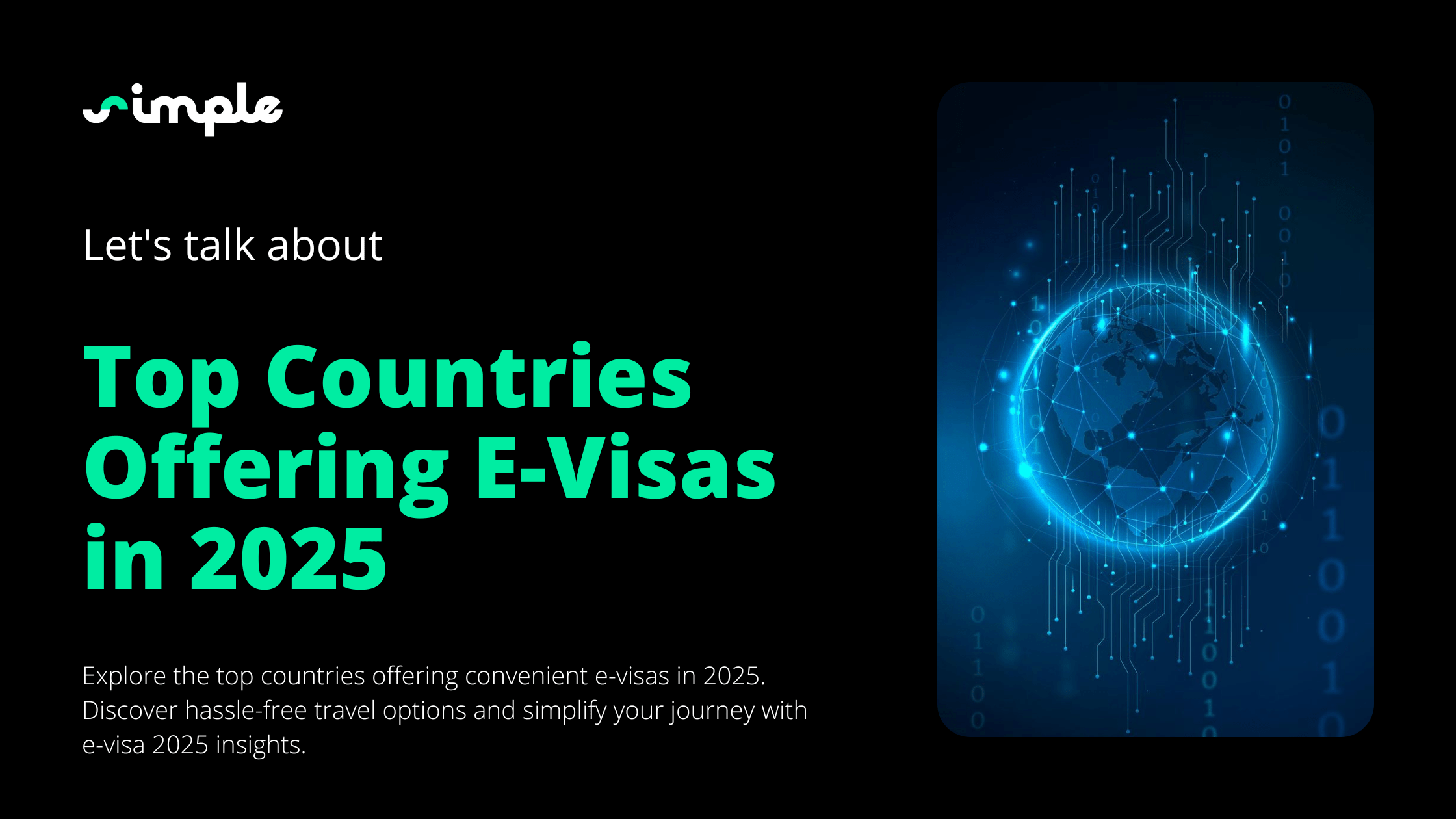Top Countries Offering E-Visas in 2025

The landscape of global travel is undergoing a significant transformation with the rising trend of e-visas. As digital travel authorization becomes increasingly prevalent, e-visas are reshaping how travelers plan and execute their journeys. These electronic visa processes offer unparalleled convenience and efficiency, eliminating the need for traditional, time-consuming visa applications. By streamlining the process, e-visas are not only enhancing the travel experience but also boosting international tourism and economic growth.
In 2025, several countries are set to lead the way with innovative e-visa programs, making travel more accessible and secure for millions of people worldwide. These nations are embracing digital immigration solutions to cater to the evolving needs of global travelers. As we delve into the top countries offering e-visas in 2025, it becomes evident that the future of travel is digital, efficient, and user-friendly. For more information on the latest developments in e-visas, visit our e-visa 2025 page.

Leading Countries with Robust E-Visa Systems
India
India has long been at the forefront of adopting digital solutions to enhance its tourism sector, and its e-visa system is a testament to this commitment. The country’s established electronic visa process has significantly influenced global tourism by making it easier for travelers from around the world to explore its rich cultural heritage and diverse landscapes. The online visa application system in India is designed to be user-friendly, allowing applicants to complete the process from the comfort of their homes. This convenience has been a major draw for tourists, contributing to a steady increase in visitor numbers over the years.
One of the key benefits of India’s e-visa system is the simplified application process. Travelers can apply for an e-visa by filling out a straightforward online form, uploading necessary documents, and paying the e-visa application fee electronically. The e-visa processing time is typically short, often taking just a few days, which adds to the appeal for last-minute travelers. Moreover, the secure e-visa system ensures that personal data is protected, providing peace of mind to applicants.
India’s e-visa program has also enhanced accessibility for tourists by offering multiple entry options and longer validity periods. This flexibility allows visitors to explore the country at their own pace, encouraging longer stays and more in-depth travel experiences. As a result, the e-visa system has not only boosted tourism but also contributed to the local economy by increasing spending in various sectors. With continuous improvements and updates, India’s e-visa system is poised to remain a leader in digital travel authorization, setting a benchmark for other countries to follow.
Australia
Australia’s e-visa program is a critical component of its strategy to facilitate seamless entry for tourists and enhance the overall travel experience. Known for its stunning natural landscapes and vibrant cities, Australia attracts millions of visitors each year, and its digital immigration solutions play a vital role in managing this influx efficiently. The electronic travel document system in Australia is designed to be intuitive and accessible, allowing travelers to apply for a visa online with ease.
The impacts of Australia’s e-visa program on the travel industry are profound. By streamlining the visa application 2025 process, Australia has reduced the administrative burden on both travelers and immigration officials, leading to faster processing times and improved customer satisfaction. This efficiency is particularly beneficial for the tourism industry, as it encourages more visitors to choose Australia as their destination, knowing that the entry process will be hassle-free.
Furthermore, Australia’s commitment to maintaining a secure e-visa system ensures that the integrity of its borders is upheld while still providing a welcoming environment for international tourists. The country’s focus on digital travel authorization has also allowed it to adapt quickly to changing global travel trends, positioning it as a forward-thinking leader in the e-visa space. As Australia continues to refine its e-visa offerings, it remains a prime example of how technology can be leveraged to enhance the travel experience and support the tourism sector.
United Arab Emirates
The United Arab Emirates (UAE) has made significant strides in developing its e-visa technology, positioning itself as a hub for business tourism and cultural exchanges. The UAE’s strategic advancements in virtual visa services have been instrumental in attracting a diverse range of visitors, from business professionals to leisure travelers. The country’s e-visa system is designed to be efficient and user-friendly, providing a seamless experience for applicants.
One of the standout features of the UAE’s e-visa program is its focus on supporting business tourism. By offering streamlined e-visa requirements 2025 and processes, the UAE has made it easier for business travelers to attend conferences, meetings, and exhibitions in the region. This emphasis on facilitating business travel has not only boosted the UAE’s economy but also strengthened its position as a global business hub.
In addition to business tourism, the UAE’s e-visa system also supports cultural exchanges by making it easier for tourists to explore the country’s rich heritage and modern attractions. The electronic visa process is designed to accommodate a wide range of travelers, with options for different visa types and durations. This flexibility, combined with the UAE’s commitment to maintaining a secure e-visa system, ensures that visitors can enjoy their stay with confidence.
As the UAE continues to innovate and expand its e-visa offerings, it remains a leader in the global e-visa trends, setting an example for other countries looking to enhance their digital immigration solutions. The UAE’s focus on leveraging technology to improve the travel experience is a testament to its forward-thinking approach and dedication to fostering international connections.

Emerging Leaders in E-Visa Implementation
Vietnam
Vietnam is rapidly emerging as a key player in the e-visa landscape, driven by its commitment to enhancing tourism through digital innovation. The country’s growing e-visa infrastructure is a response to the increasing demand from international travelers eager to explore its rich cultural heritage and stunning natural landscapes. By adopting a robust electronic visa process, Vietnam is making significant strides in simplifying travel for visitors from around the globe.
The advantages of Vietnam’s e-visa system are manifold, benefiting both travelers and the national economy. For tourists, the online visa application process is straightforward and efficient, allowing them to obtain a travel permit online without the need for lengthy paperwork or in-person visits to embassies. This convenience is particularly appealing to the modern traveler, who values speed and simplicity in travel arrangements. The e-visa processing time is also notably quick, ensuring that visitors can plan their trips with minimal delay.
From an economic perspective, Vietnam’s investment in digital travel authorization is paying dividends. By making it easier for tourists to visit, the country is experiencing a boost in tourism-related revenue, which in turn supports local businesses and communities. The secure e-visa system also enhances Vietnam’s appeal as a safe and welcoming destination, encouraging repeat visits and positive word-of-mouth among travelers. As Vietnam continues to refine its e-visa offerings, it is well-positioned to capitalize on global e-visa trends and further solidify its status as a top travel destination.
Kenya
Kenya is at the forefront of digitalizing its visa processes, with a strong focus on leveraging technology to enhance the travel experience. The country’s e-visa system is a critical component of its strategy to attract more visitors to its renowned wildlife and eco-tourism attractions. By streamlining the visa application 2025 process, Kenya is making it easier for tourists to experience its unique natural beauty and diverse ecosystems.
The digitalization of Kenya’s visa processes offers numerous benefits to both travelers and the tourism sector. For visitors, the ability to apply for a visa online and receive an electronic travel document simplifies the planning process, allowing them to focus on enjoying their trip. The e-visa eligibility criteria are designed to be inclusive, accommodating a wide range of travelers and ensuring that Kenya remains accessible to tourists from all over the world.
Kenya’s focus on virtual visa services is also transforming its wildlife and eco-tourism sectors. By facilitating easier access for international tourists, the country is able to attract more visitors to its national parks and conservation areas, generating vital revenue for conservation efforts and local communities. The secure e-visa system also ensures that Kenya can manage its borders effectively while still providing a warm welcome to travelers. As Kenya continues to innovate in the realm of digital immigration solutions, it is setting a benchmark for other countries looking to enhance their tourism offerings through technology.
Brazil
Brazil is embracing tech-driven solutions to improve visa accessibility and attract a broader range of international tourists. The country’s integration of digital travel authorization into its visa processes is a key part of its strategy to boost tourism and showcase its vibrant culture and diverse landscapes. By adopting an electronic visa process, Brazil is making it easier for travelers to explore its many attractions, from the Amazon rainforest to the bustling streets of Rio de Janeiro.
The effects of Brazil’s e-visa system on international tourist demographics are significant. By offering a streamlined online visa application process, Brazil is able to attract visitors from a wider array of countries, enhancing its appeal as a global travel destination. The e-visa requirements 2025 are designed to be straightforward and accessible, ensuring that travelers can obtain the necessary documentation with minimal hassle. This ease of access is particularly important for attracting tourists who may have been deterred by more cumbersome visa processes in the past.
Brazil’s focus on digital immigration solutions is also having a positive impact on its tourism industry. By reducing barriers to entry, the country is experiencing an increase in visitor numbers, which in turn supports local businesses and stimulates economic growth. The secure e-visa system also ensures that Brazil can maintain the integrity of its borders while still providing a welcoming environment for international travelers. As Brazil continues to refine its e-visa offerings, it is poised to become a leader in the future of e-visas, setting an example for other nations looking to enhance their tourism sectors through technology.

Innovations and Future Trends in E-Visa Technology
Automation and AI in Processing
The integration of automation and artificial intelligence (AI) in e-visa processing is revolutionizing the way visa applications are handled, offering significant improvements in efficiency and accuracy. Automation is playing a crucial role in reducing waiting times and minimizing error rates in the electronic visa process. By automating routine tasks such as data entry and document verification, e-visa systems can process applications more quickly and with greater precision, ensuring that travelers receive their travel permits online in a timely manner.
AI-powered personalization is another promising development in the realm of virtual visa services. By leveraging machine learning algorithms, e-visa platforms can tailor the application experience to individual travelers, providing customized recommendations and guidance based on their specific needs and travel history. This level of personalization not only enhances the user experience but also increases the likelihood of successful visa applications by ensuring that applicants meet all necessary e-visa requirements 2025.
The potential for AI in digital travel authorization extends beyond personalization. Advanced AI systems can analyze vast amounts of data to identify patterns and trends, enabling immigration authorities to make more informed decisions about visa approvals. This capability is particularly valuable in the context of global e-visa trends, where the ability to adapt to changing travel patterns and security concerns is paramount. As automation and AI continue to evolve, they are set to play an increasingly important role in shaping the future of e-visas, offering new opportunities for innovation and efficiency in visa processing.
Biometric Enhancements
The incorporation of biometric systems into e-visa technology is enhancing security and streamlining the application process, providing a more seamless experience for travelers. Biometric enhancements, such as fingerprint scanning and facial recognition, offer a higher level of security by verifying the identity of applicants with greater accuracy than traditional methods. This added layer of security is crucial in maintaining the integrity of the secure e-visa system, ensuring that only legitimate travelers are granted entry.
In addition to improving security, biometric systems also contribute to more efficient processing of visa applications. By automating identity verification, biometric technology reduces the need for manual checks, speeding up the e-visa processing time and allowing travelers to receive their electronic travel documents more quickly. This efficiency is particularly beneficial in high-volume travel periods, where the ability to process large numbers of applications swiftly is essential.
Predictive analytics is another area where biometric enhancements are making a significant impact. By analyzing biometric data alongside other information, immigration authorities can gain valuable insights into traveler behavior and potential security risks. This capability allows for more proactive management of visa approvals, enhancing traveler safety and ensuring that e-visa eligibility criteria are met. As biometric technology continues to advance, it is poised to play a central role in the future of e-visas, offering new possibilities for enhancing both security and efficiency in visa processing.
Cross-Border Collaborations
International partnerships and cross-border collaborations are playing a pivotal role in the standardization of e-visa platforms, paving the way for more seamless travel experiences. By working together, countries can develop shared standards and protocols for e-visa systems, ensuring that travelers can navigate the visa application 2025 process with ease, regardless of their destination. These collaborations are essential in creating a more cohesive global travel ecosystem, where digital immigration solutions are harmonized across borders.
The impact of cross-border collaborations extends beyond standardization. By sharing data and resources, countries can enhance the security and efficiency of their e-visa systems, reducing the risk of fraud and improving the accuracy of visa approvals. Shared databases and multi-country e-visa solutions are emerging as key components of this collaborative approach, allowing travelers to apply for visas to multiple destinations through a single platform. This innovation not only simplifies the application process but also encourages more international travel by reducing the administrative burden on travelers.
The future outlook for cross-border collaborations in e-visa technology is promising, with the potential to transform the way we think about travel and immigration. As countries continue to work together to develop and implement shared e-visa solutions, the possibilities for innovation and efficiency are endless. By embracing these collaborations, the global travel industry can create a more connected and accessible world, where the barriers to international travel are minimized, and the opportunities for exploration and cultural exchange are maximized.

Conclusion
The transformative role of e-visas in facilitating global travel and tourism in 2025 cannot be overstated. As we have explored, the adoption of digital travel authorization and electronic visa processes by leading countries is revolutionizing the way people travel. By offering streamlined online visa applications and secure e-visa systems, these nations are making international travel more accessible, efficient, and secure. The future of e-visas is bright, with continuous advancements in technology promising even greater improvements in the travel experience. From reducing waiting times and error rates through automation to enhancing security with biometric systems, e-visas are setting new standards for convenience and reliability in the tourism industry.
As we look ahead, it is crucial for both travelers and policymakers to embrace the ongoing developments and improvements in e-visa systems. For travelers, staying informed about the latest e-visa requirements 2025 and leveraging digital immigration solutions can enhance their travel experiences, making it easier to explore new destinations and cultures. For policymakers, supporting the adoption of innovative e-visa technologies and fostering cross-border collaborations can drive economic growth and strengthen international relations. By working together, we can create a more connected world where the barriers to travel are minimized, and the opportunities for cultural exchange and understanding are maximized. The journey towards a more seamless and integrated global travel ecosystem is well underway, and the continued evolution of e-visas will play a pivotal role in shaping the future of international tourism.